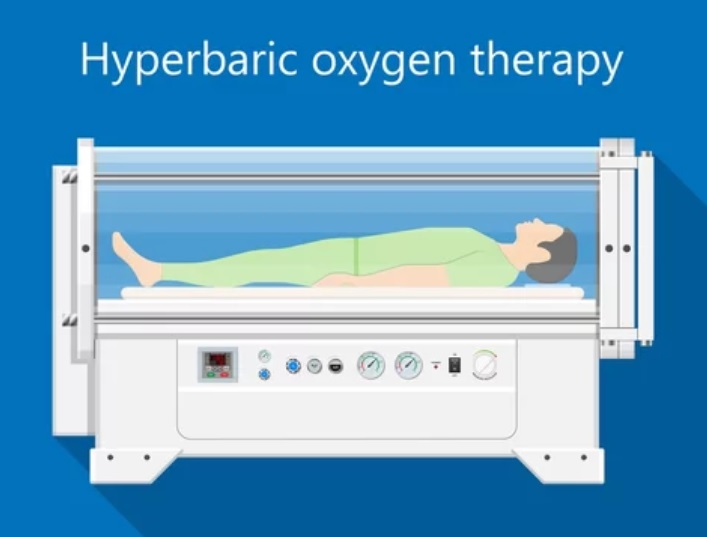Hyperbaric Oxygen Therapy (HBOT) involves breathing pure oxygen in a pressurized chamber. Originally developed for divers with decompression sickness, it now has various medical applications.
How Hyperbaric Oxygen Therapy Works
In HBOT, patients breathe in pure oxygen in an environment where the pressure is higher than normal.
Patient inhales 100% oxygen for 1 hour at atmospheric pressure 2.4 in a HBO2 chamber. In addition to 1 hour oxygen inhalation under pressure, the compression and decompression time of the chamber is 10–15 minutes respectively. Usually a total of 10–20 such sittings (six per week) are given.
This allows the lungs to absorb more oxygen, which is then distributed throughout the body, promoting healing and fighting infections.
Mode of Action of Hyperbaric Oxygen Therapy in Ear Diseases
1) Increased partial pressure of oxygen (up to 460% increase in pO2) in perilymph and endolymph supplies oxygen to the inner hair cells.
The pO2 level remains 60% above the normal after 1 hour of termination of hyperbaric oxygen
(HBO2) therapy.
2) Reduction of hematocrit and decrease in blood viscosity improves diffusion of oxygen to ischemic cells.
Benefits of Hyperbaric Oxygen Therapy
- Wound Healing: HBOT accelerates the healing of chronic wounds, including diabetic ulcers and injuries from radiation.
- Infection Control: It helps combat infections, especially those caused by anaerobic bacteria, by increasing oxygen levels and enhancing antibiotic effectiveness.
- Reducing Inflammation: The therapy has anti-inflammatory effects, which can help reduce swelling and aid in recovery from injuries and surgeries.
- Neurological Support: Research suggests potential benefits for conditions like traumatic brain injuries and strokes, improving cognitive function and recovery by increasing oxygen supply to the brain.
Applications of Hyperbaric Oxygen Therapy
- Decompression Sickness: Used primarily for treating divers with this condition.
- Chronic Wounds: Effective in promoting tissue repair in non-healing wounds.
- Radiation Injury: Helps restore blood flow and reduce tissue damage from cancer treatments.
- Carbon Monoxide Poisoning: Quickly displaces carbon monoxide from the bloodstream, restoring oxygen delivery to tissues.
Indications of Hyperbaric Oxygen Therapy in Ear, Nose, and Throat Ailments –
1) Sudden idiopathic sensorineural hearing loss and tinnitus
The results are better if therapy is started earlier. In various studies, improvements have been reported in 30–80% of the patients.
2) Acoustic trauma
3) Noise-induced hearing loss
4) Malignant otitis external
5) Mucormycosis of paranasal sinuses
6) Skin flaps with compromised blood supply
Safety Considerations
While generally safe, HBOT isn’t suitable for everyone.
Conditions like untreated pneumothorax or specific respiratory issues may contraindicate its use.
Side effects can include temporary vision changes or ear discomfort due to pressure changes.
Conclusion
Hyperbaric Oxygen Therapy is a versatile treatment with various applications, from enhancing wound healing to supporting neurological recovery.
As research continues, its benefits may expand further. It’s essential to consult a healthcare provider to determine if HBOT is suitable for your needs.
Thank You
MEDICAL ADVICE DISCLAIMER:
This blog, including information, content, references, and opinions, is for informational purposes only.
The Author does not provide any medical advice on this platform.
Viewing, accessing, or reading this blog does not establish any doctor-patient relationship.
The information provided in this blog does not replace the services and opinions of a qualified medical professional who examines you and then prescribes medicines.
If you have any questions of a medical nature, please refer to your doctor or the qualified medical personnel for evaluation and management at a clinic/hospital near you.
The content provided in this blog represents the Author’s own interpretation of research articles.
